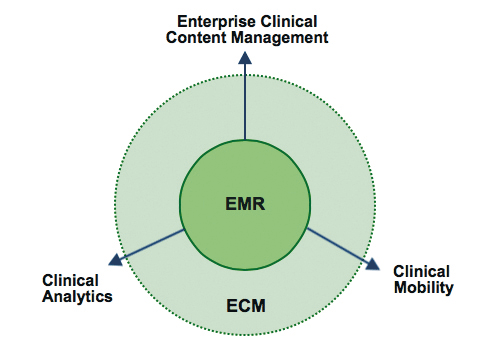Healthcare needs to maximise its EMR investment with ECM

The healthcare industry faces numerous challenges today. These include rapidly changing regulatory reporting requirements, financial constraints and demand for higher quality of care. Most hospitals have heavily invested in their core applications such as Patient Administration Systems (PAS), Clinical applications (EMR/EHR), Radiology (PACS) and billing systems. However these systems are usually database-driven, isolated repositories located far away from the systems of engagement that are essential for today’s high quality care delivery.
Enterprise Content Management (ECM) is a set of strategies, methods and tools used to capture, manage, store, preserve, and deliver both content and documents related to core and non-core processes in a hospital. The goal of this article is to highlight three areas where healthcare providers can maximise EMR investment with an ECM solution to address core health information management challenges.
Quality of care starts with meaningful collection and use of both clinical and non-clinical information. The latter is in the form of unstructured data and the amount is growing rapidly.
Three areas where Electronic Medical Record (EMR) systems are challenged today are in Enterprise Clinical Content Management, Clinical Mobility and Clinical Analytics. Healthcare organisations must have a solution to overcome these challenges before using EMR to its full potential.
These challenges can differ from one facility to the next. Whether you are already using an EMR solution or planning your EMR implementation in the future, the ideas shared in this article will help you stop bleeding critical clinical and non-clinical data and reduce operational costs while creating a rich patient engagement.
Enterprise Clinical Content Management
It is estimated that 80% of the content generated as a result of care cycle or episode is unstructured and the amount is growing faster than ever before. In recent years, several primary and secondary care organisations from small practices to major hospitals have implemented electronic medical record (EMR) solutions to replace inefficient paper-based processes. The reality is EMR systems are only good as the data that is fed into them.
Unfortunately clinical and non-clinical content cannot fit into database models directly without a meaningful indexing and metadata strategy. Relying purely on an EMR solution to drive the lifecycle of the content has been tried and failed as a strategy with poor user adoption.
Healthcare providers today need to be more collaborative with content than ever before and proactive in capturing and processing the care-related content. This often must take place at the point of origination with minimal or no manual processing involved. This is a core area ignored by most EMR systems out there and provides an opportunity to maximise an EMR investment via an ECM solution that manage the full lifecycle of content.
When all electronic content is organised in a meaningful manner in conjunction with an EMR:
- It serves as a medium of communication and collaboration between doctors and other healthcare professionals both internal and external;
- provides proof to insurance companies for insurance claims;
- can be used in court in the event of a malpractice claim, FOI requests or Audits; and
- can be used for research and clinical coding.
-

Clinical Analytics
Clinical data analytics can analyse process performance and compliance against set standards across all tasks, revealing new efficiencies and cost savings that would otherwise remain undiscovered. The reason why analytics is necessary in a healthcare environment is because processes today span multiple applications. The processes today are unpredictable.
Modern analytics collects data from multiple internal and external applications and provides visual dashboards showing what’s happening in realtime. This provides early warning and allows taking preventive actions.
Analytics enables healthcare organisations to discover new insights hidden within organisational processes and identify strategic business opportunities and risks. It also provides decision makers and end users direct and unprecedented visibility to proactively resolve problems, eliminate delays, and improve quality of service.
This differs from typical EMR reporting and traditional business intelligence which shows what happened in the past at a point in time.
Here are a few scenarios showing potential uses for modern data analytics solutions utilising operational data coming out from your EMR, PAS, PACS, Finance and billing systems:
- Real-time monitoring of metrics for patient safety, length of stay, readmission rates and much more;
- Analyse emergency room patient processing by task – from admission to discharge, including lab, radiology and other services spanning multiple departments and systems of record – to identify root causes of excessive wait times, monitor procedure compliance and manage risk;
- Monitor detailed performance and quality metrics within service areas in realtime to improve turnaround times, reduce reprocessing and improve operational visibility;
- Minimise uncompensated care through timely management of insurance claims and patient billing/collections;
- Ensure proper insurer reimbursements, including identifying underpayments for procedures performed;
- Effectively negotiate with insurers using historical analysis to gain the highest possible contractual reimbursement levels from insurers;
- Optimise staffing and scheduling using census metrics, updated constantly throughout the day;
- Improve equipment utilisation rates to ensure productivity at or better than benchmark Relative Value Unit (RVU) rates; and
- Enable informed materials management decisions to achieve order efficiencies, minimise waste and expense.
Clinical mobility
In a healthcare provider, the importance of accurate, instant and up-to-date communication can’t be understated. Providing a rich patient engagement starts even before the patient is admitted to the hospital to ensure they are well prepared for the appointment to get the most out of the clinician’s valuable time.
For certain chronic patients this engagement does not end following discharge from the hospital. Preventive healthcare consists of measures taken for disease prevention, as opposed to disease treatment. This is a key element in achieving patient satisfaction and winning the trust and credibility that is needed to support an accountable care delivery model.
An ECM solution can easily extend existing process boundaries to interact with the patient and providing a rich engagement via their preferred channel, i.e. the smartphone.
The electronic forms and workflow capability of modern ECM solutions can enhance inbound and outbound communication with patients and other external parties. These processes operate outside the core EMR but provide the essential data and information it needs for optimal performance. There are many ways that healthcare providers can maximise an EMR investment via an ECM solution providing the valuable data that it needs to operate as a single source of truth.
Here are some examples:
- Patient registration and admission, on-boarding process automation;
- Patient education and alerts as part of extended community care;
- Capture supporting documents via mobile device at allied health site visits;
- Conducting electronic patient survey and satisfaction measurements;
- Expense management; and
- Billing and e-invoicing.
Information is the lifeblood of any healthcare provider and if the quality of that information isn’t properly governed, it can hurt core operations. Poor data quality can lead to higher costs, operational inefficiencies, compliance risks and an overall lack of trust. The key to filling this gap today is to build the missing capabilities outside your core EMR system with the right level of data integration.
This approach gives you more flexibility and agility to adopt your solution with changing business needs around people, processes and content.
This hybrid solution approach also promotes the concept of services oriented architecture and reduces the risk of over relying on your EMR system to deliver everything that your users will ask to deliver. When it comes to health information management the best of breed approach with right level of integration wins over all in one approach which is not a practical reality.
Effective health information management is about about co-ordinating, advocating, controlling resources, making judgments, escalating, tracking with analytics which require collecting and using health information in a meaningful manner. By deploying an ECM system alongside with core EMR modules, healthcare organisations can gain significant cost efficiencies and ensure compliance with a fraction of a cost involved in full suite EMR adoption.
Nalaka Withanage is the founder and CEO of Data Capture Experts, a solution provider that has worked with several leading Australian organisations. Email him at nalaka@datacaptureexperts.com.au
